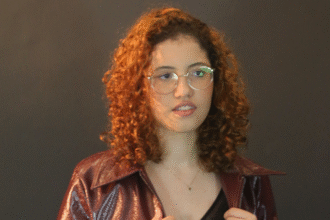The talented actress Agnes Brichta, member of the cast of the highly anticipated play “The Tartuffe”, is ready to shine on the stage of the Centro Cultural da Justiça Federal, starting on November 17th, with performances from Friday to Sunday, at 7 pm, until 10 am from December.
The plot of the play reveals the story of Tartuffe, a hypocrite and false puritan, who takes advantage of Orgonte’s blind faith to carry out a coup and enrich himself at his expense. With sharp humor, the play brings to light the discussion about the abuse of power and the dangers of blind trust.
Directed by Bruce Gomlevsky, the production features Molière’s classic text, translated by Guilherme Figueiredo, with an irreverent approach that mixes the classical rigor of the verse with contemporary Brazilian elements, such as funk and football, as well as audiovisual resources.
Bruce Gomlevsky, a prestigious director recognized for his creative adaptations, such as George Orwell’s recent “Animal Farm”, provides an innovative production, seeking a direct connection between the contemporary audience and the aspects of everyday life presented on stage. The cast, formed by the talented “Coletivo Descalços”, stands out for its harmony and rapport, highlighting the strong scenic play between its members.
Agnes Brichta, with a solid theater training that began in 2002, is recognized not only for her role in soap operas, such as “Quanto Mais Vida Melhor”, but also for her award-winning performance in theater, receiving the title of best actress at the Sarau Celebração CAL 2017 and nomination as best actress at FETAERJ 2022.
In addition to her involvement in “O Tartufo”, Agnes Brichta also shines as a musician and singer in the show “Quem vem de Fora, Vatapá Vambora”, directed and written by André Arteche, starring Ari Guimas. The work brings the captivating story of the difficulties and dreams that lead northeasterners to migrate to Rio de Janeiro, accompanied by live music, predominantly from Bahia.
The versatility of Agnes Brichta, originally from Sergipe, stands out not only in her character acting, but also in her artistic expression through music, consolidating her remarkable presence on Brazilian stages.
Can you share more about your role in “Tartuffe” and how you prepared to play this quirky character?
My role in “O Tartuffe” is Cleanto, a very intelligent man, with beautiful reflections on humanity and faith, but his greatest tragedy is being tied to the dangers of Tartuffe, as he is just a member of Orgonte’s house. It’s very interesting to be playing a male character, something that theater allows us to do more calmly and routinely than audiovisual. One of the first tasks in the process was precisely to let go of the attempt to create a male figure and focus on building a character independent of gender. I always remember Hamlet, by Cia Armazem, with Patricia Selonk teaching a class on building humanity that goes beyond gender. As Tartuffe is a classic, another challenge was to approximate the text so that it became clear and true. To do this, I watched many plays in verse, read different translations of the play and studied not only The Tartuffe but also other rhymed texts. The goal is to share this story, the rhyme is a consequence.
The play addresses themes such as abuse of power and blind trust. How do you believe these themes resonate with you and contemporary audiences?
The habits of pretending to be what you are not and relying too much on appearances are well known to all of us who live in times of social media, fake news and the internet. That’s why it’s so easy to understand and recognize the good faith of Orgonte, the father of the family who is deceived throughout the play. I think the desire to believe in something or someone resonates a lot with all of us in these days, so marked by uncertainty and abuse of power, which is why Tartuffe’s dissimulation affects us in a very personal and tragicomic way.
Director Bruce Gomlevsky is known for his creative adaptations. What was it like for you to work under his direction and integrate Brazilian elements, such as funk and football, into a classic piece like “O Tartufo”?
Bruce Gomlevsky’s proposal to mix verses with current Brazilian everyday life was essential to bring the entire play closer to us (actors and audience). I think it’s wonderful when classics are presented in an accessible and new way, after all, if we’re going to revisit something, let it be different. Furthermore, being able to put together O Tartufo with Brazilian and current elements shows that this story is still repeated today and here.
You mentioned that the play seeks to connect the public with aspects of everyday life. How is this achieved in the staging, and in what ways do you think modern audiences can identify with Molière’s classic plot?
It was through the experimentation of the cast, very creative and humorous in their explorations, that we discovered that the play is more current than we thought. Who doesn’t know a family at odds, a stubborn relative, a young couple fighting for their family’s consent, a more impulsive and hotheaded boy or even the danger of believing in someone who doesn’t deserve trust? What Molière offers is timeless and we make it everyday and Brazilian through the construction of the characters, the costumes, the soundtrack, the habits, the scenic elements and even the accent.
Can you tell us a little more about “Coletivo Descalços” and how the group’s dynamics influence your theatrical experience?
Coletivo Descalços is made up of actors who met on the technical theater course at CAL and are making their professional debut with this show. Being in a group creating our own play is an intense experience that makes us understand in practice the collective nature of theater making. It’s a challenge but it’s liberating and necessary. In O Tartufo we want to tell this story clearly, entertaining the audience, and it’s really cool to see how creative this group of actors is, stimulating each other in exchange and experimentation.
His debut in soap operas was in “Quanto Mais Vida Melhor”. What was the transition between television and theater like for you, and what did you learn from these different forms of acting?
I spent twenty years studying theater but it wasn’t so immediate to remember the specificities of this language after a year of soap operas. I missed looking the audience in the eye to tell a story and I also miss the audiovisual! The truth is that it is very pleasurable to be able to do what I love in all possible formats, I believe that truthful storytelling is the guiding principle of acting, regardless of whether we are talking about TV, cinema or theater.
In addition to acting, you are involved in other aspects of the artistic world, such as the music in the show “Quem vem de Fora, Vatapá Vambora”. Can you share your experience in this musical role and how it complements your performance?
I’m taking my first steps in singing live with the show “Quem vem de Fora, Vatapá Vambora”. I was already singing on the internet and I knew that I wanted to delve deeper into this. All it took was the invitation from André Arteche and Ari Guimas to get me really excited. The enchantment for music was already in me and I think it’s here to stay and to add to my acting.
In the current scenario, where art faces significant challenges, how do you see the role of theater and cultural productions in society, and what is the importance of keeping artistic expression alive?
I see a lot of value in the unique, in-person meeting that only theater offers. Knowing that what happens in a play is the result of the day, of the show’s encounter with the audience and will never happen again in the same way is very unusual these days, with the online world expanding so much. As an artist, artistic expression is an electrifying adventure, as a spectator, it is a fundamental breather from the speed and problems of everyday life.
Do you have any behind-the-scenes stories or moments from “The Tartuffe” that you would like to share with us?
At the beginning of the process, we considered making the characters the genders that the actors identify with in their lives. At that moment, I, with my mind restless and wanting to build a strong figure, proposed that Cleanto-woman was pregnant and it was really cool to deal with this option, create the explanations and research the body. We still miss Cleanto being pregnant today in rehearsals!
What does the future hold for Agnes Brichta in terms of artistic projects? Is there anything you are looking forward to exploring in your career?
I have many wishes for my professional future. I really want to return to audiovisual and I’m also enjoying the shows I’m doing as an actress and singer. The show “Quem vem de Fora Vatapá Vambora” should return and I am also venturing into dramaturgy.
Follow Agnes Brichta onInstagram





